Linear model POD¶
[1]:
# import relevant module
import openturns as ot
import otpod
# enable display figure in notebook
try:
%matplotlib inline
except:
pass
/calcul/home/dumas/anaconda/lib/python3.6/site-packages/sklearn/ensemble/weight_boosting.py:29: DeprecationWarning: numpy.core.umath_tests is an internal NumPy module and should not be imported. It will be removed in a future NumPy release.
from numpy.core.umath_tests import inner1d
Generate data¶
[2]:
N = 100
ot.RandomGenerator.SetSeed(123456)
defectDist = ot.Uniform(0.1, 0.6)
# normal epsilon distribution
epsilon = ot.Normal(0, 1.9)
defects = defectDist.getSample(N)
signalsInvBoxCox = defects * 43. + epsilon.getSample(N) + 2.5
# Inverse Box Cox transformation
invBoxCox = ot.InverseBoxCoxTransform(0.3)
signals = invBoxCox(signalsInvBoxCox)
Build POD using previous linear analysis¶
[3]:
# run the analysis with Gaussian hypothesis of the residuals (default case)
analysis = otpod.UnivariateLinearModelAnalysis(defects, signals, boxCox=True)
[4]:
# signal detection threshold
detection = 200.
# Use the analysis to build the POD with Gaussian hypothesis
# keyword arguments must be given
PODGauss = otpod.UnivariateLinearModelPOD(analysis=analysis, detection=detection)
PODGauss.run()
Build POD with Gaussian hypothesis¶
[5]:
# The previous POD is equivalent to the following POD
PODGauss = otpod.UnivariateLinearModelPOD(defects, signals, detection,
resDistFact=ot.NormalFactory(),
boxCox=True)
PODGauss.run()
Get the R2 value of the regression¶
[6]:
print('R2 : {:0.3f}'.format(PODGauss.getR2()))
R2 : 0.895
Compute detection size¶
[7]:
# Detection size at probability level 0.9
# and confidence level 0.95
print(PODGauss.computeDetectionSize(0.9, 0.95))
# probability level 0.95 with confidence level 0.99
print(PODGauss.computeDetectionSize(0.95, 0.99))
[a90 : 0.303982, a90/95 : 0.317157]
[a95 : 0.323048, a95/99 : 0.343536]
get POD Function¶
[8]:
# get the POD model
PODmodel = PODGauss.getPODModel()
# get the POD model at the given confidence level
PODmodelCl95 = PODGauss.getPODCLModel(0.95)
# compute the probability of detection for a given defect value
print('POD : {:0.3f}'.format(PODmodel([0.3])[0]))
print('POD at level 0.95 : {:0.3f}'.format(PODmodelCl95([0.3])[0]))
POD : 0.886
POD at level 0.95 : 0.834
Show POD graphs¶
Only the mean POD¶
[9]:
fig, ax = PODGauss.drawPOD()
fig.show()
/calcul/home/dumas/anaconda/lib/python3.6/site-packages/matplotlib/figure.py:459: UserWarning: matplotlib is currently using a non-GUI backend, so cannot show the figure
"matplotlib is currently using a non-GUI backend, "
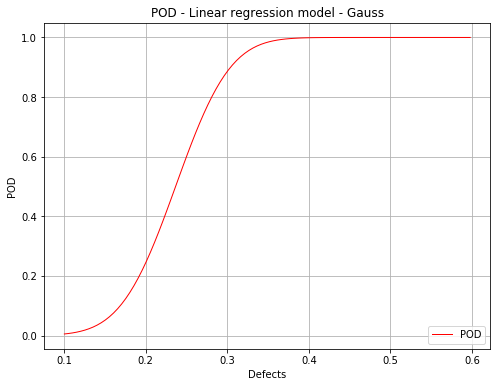
Mean POD with the detection size for a given probability level¶
[10]:
fig, ax = PODGauss.drawPOD(probabilityLevel=0.9)
fig.show()
/calcul/home/dumas/anaconda/lib/python3.6/site-packages/matplotlib/figure.py:459: UserWarning: matplotlib is currently using a non-GUI backend, so cannot show the figure
"matplotlib is currently using a non-GUI backend, "
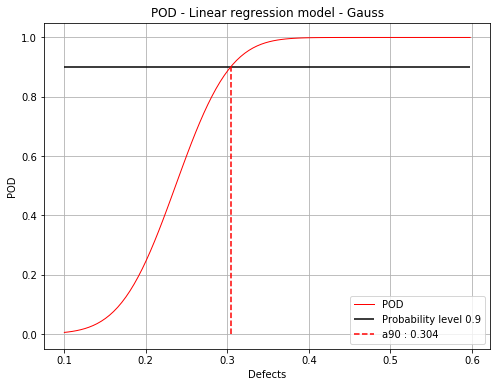
Mean POD with POD at confidence level¶
[11]:
fig, ax = PODGauss.drawPOD(confidenceLevel=0.95)
fig.show()
/calcul/home/dumas/anaconda/lib/python3.6/site-packages/matplotlib/figure.py:459: UserWarning: matplotlib is currently using a non-GUI backend, so cannot show the figure
"matplotlib is currently using a non-GUI backend, "
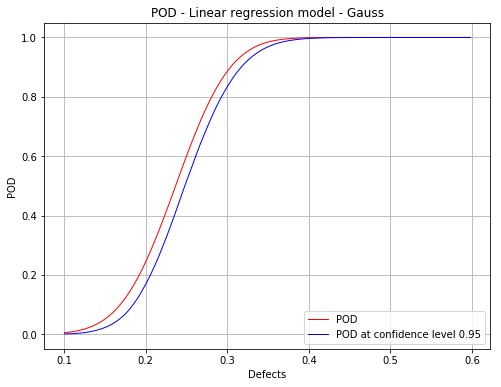
Mean POD and POD at confidence level with the detection size for a given probability level¶
[12]:
fig, ax = PODGauss.drawPOD(probabilityLevel=0.9, confidenceLevel=0.95,
name='figure/PODGauss.png')
# The figure is saved in PODGauss.png
fig.show()
/calcul/home/dumas/anaconda/lib/python3.6/site-packages/matplotlib/figure.py:459: UserWarning: matplotlib is currently using a non-GUI backend, so cannot show the figure
"matplotlib is currently using a non-GUI backend, "

Build POD with no hypothesis on the residuals¶
This corresponds with the Berens Binomial method.
[13]:
PODBinomial = otpod.UnivariateLinearModelPOD(defects, signals, detection, boxCox=True)
PODBinomial.run()
[14]:
# Detection size at probability level 0.9
# and confidence level 0.95
print(PODBinomial.computeDetectionSize(0.9, 0.95))
[a90 : 0.298739, a90/95 : 0.329606]
[15]:
fig, ax = PODBinomial.drawPOD(0.9, 0.95)
fig.show()
/calcul/home/dumas/anaconda/lib/python3.6/site-packages/matplotlib/figure.py:459: UserWarning: matplotlib is currently using a non-GUI backend, so cannot show the figure
"matplotlib is currently using a non-GUI backend, "
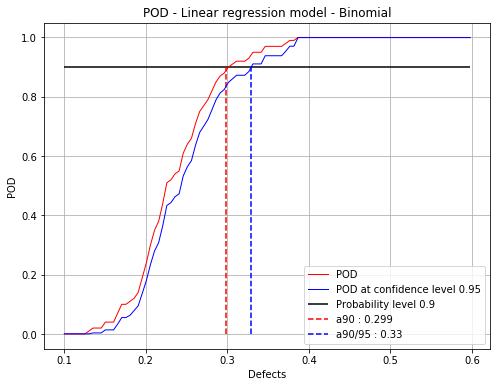
Build POD with kernel smoothing on the residuals¶
The POD at the given confidence level is built using bootstrap. It may take few seconds. A progress bar if displayed is in this case. It can be remove using setVerbose(False)
[16]:
PODks = otpod.UnivariateLinearModelPOD(defects, signals, detection,
resDistFact=ot.KernelSmoothing(),
boxCox=True)
PODks.run()
Computing POD (bootstrap): [==================================================] 100.00% Done
[17]:
# Detection size at probability level 0.9
# and confidence level 0.95
print(PODks.computeDetectionSize(0.9, 0.95))
[a90 : 0.308381, a90/95 : 0.330921]
[18]:
fig, ax = PODks.drawPOD(0.9, 0.95)
fig.show()
/calcul/home/dumas/anaconda/lib/python3.6/site-packages/matplotlib/figure.py:459: UserWarning: matplotlib is currently using a non-GUI backend, so cannot show the figure
"matplotlib is currently using a non-GUI backend, "
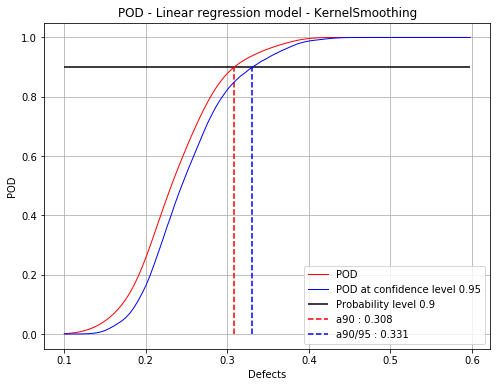
[ ]:
 otpod
otpod